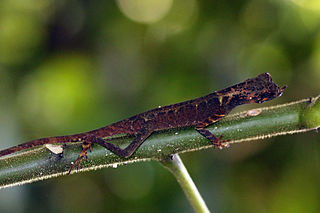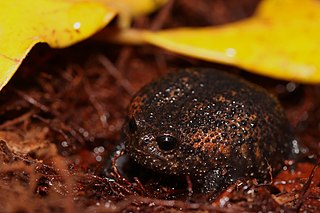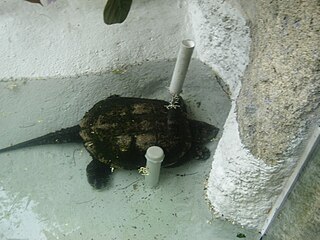
Aphaniotis is a genus of agamid lizards from Southeast Asia.

Coryphophylax is an agamid genus endemic to the Andaman and Nicobar Islands and a sister of the Southeast Asian Aphaniotis. Found in tropical wet forests, they are common in suitable habitats and shows variations across islands and are sexually dimorphic. The genus is absent on Great Nicobar Island, with its southernmost occurrence on the Island of Kondul. The Tsunami of December 2004 may have affected island wise distributions in the Nicobar Islands of several species and also their gene-flow.

Taudactylus is a genus of frogs in the family Myobatrachidae. These frogs are endemic to rainforest areas of coastal eastern Australia, most of this genus inhabit fast flowing streams in highland area. Most members of this genus have suffered serious declines, in which the disease chytridiomycosis appears to have played a significant role: T. diurnus is believed to be extinct, while all others except T. liemi are listed as critically endangered by the IUCN. These listings are conservative, and it is likely T. acutirostris, presently listed as critically endangered, already is extinct.
Rhinella acutirostris is a species of toad in the family Bufonidae. It is found in Brazil, Colombia, Panama, and Venezuela. Its natural habitats are subtropical or tropical moist lowland forests, freshwater marshes, and intermittent freshwater marshes.

Hyperolius acutirostris is a species of frog in the family Hyperoliidae. It is endemic to southwestern Cameroon, found as far east as the region of Yaoundé. Common name sharpsnout reed frog has been coined for it.
Pristimantis acutirostris is a species of frog in the family Strabomantidae.

Breviceps acutirostris, also known as common rain frog, strawberry rain frog, or Cape short-headed frog, is a species of frog in the family Brevicipitidae. It is endemic to the southwestern Cape region in South Africa. It is burrowing frog that lives in fynbos heatland and forests at elevations below 1,600 m (5,200 ft) above sea level. Development is direct . It is threatened by habitat loss, although much of its habitat is also protected.
The sharp snouted day frog, or sharp-nosed torrent frog, is a species of frog in the family Myobatrachidae. It is endemic to upland rainforest streams in north-eastern Queensland in Australia.

Philautus acutirostris is a species of frog in the family Rhacophoridae. It is endemic to the Philippines. Its natural habitats are subtropical or tropical moist lowland forests and subtropical or tropical moist montane forests. It is threatened by habitat loss.

Hume's short-toed lark is a species of lark in the family Alaudidae. It is found in south-central Asia from Iran and Kazakhstan to China.

The marsh antwren, also known as the Paraná antwren, is an insectivorous bird in the antbird family Thamnophilidae. It is endemic to marshes and swamps in the Brazilian states of Paraná and Santa Catarina.

Astragalus acutirostris is a species of milkvetch known by the common name sharpkeel milkvetch. It is native to the Mojave Desert and surroundings of California, Nevada, and Arizona, where it grows in dry, sandy, gravelly areas.

The South American snapping turtle is a species of turtle in the family Chelydridae. This species, which is endemic to Central and northwestern South America, was previously considered a subspecies of Chelydra serpentina. Its restricted range in South America reflects its recent arrival there as part of the Great American Interchange.
The Sharpnose worm eel is an eel in the family Ophichthidae. It was described by Max Carl Wilhelm Weber and Lieven Ferdinand de Beaufort, originally under the genus Muraenichthys. It is a marine, tropical eel which is known from Indonesia, in the western Pacific Ocean. It inhabits sandy areas near reefs. Males can reach a maximum total length of 10 centimetres (3.9 in).

Arius acutirostris is a species of catfish in the family Ariidae. It is a fresh- and brackish-water species that inhabits lower reaches of tidal rivers and estuaries. It is known from the Irrawaddy and Salween River basins in Myanmar and from the Kraburi River estuary in Thailand. It grows to 40 cm (16 in) in length.

Mycteroperca acutirostris the comb grouper, western comb grouper or wavy-lined grouper, is a species of grouper from the family Serranidae from the warmer waters of the western Atlantic Ocean.

Polychrus acutirostris, the Brazilian bush anole, is a species of lizard native to southern and eastern Brazil, Paraguay, Argentina, and eastern Bolivia. It is diurnal.

Aphaniotis fusca, the dusky earless agama or peninsular earless agama, is a species of lizard in the family Agamidae. The species is found in Thailand, Malaysia, and Indonesia.

Wladysagitta is an extinct genus of osteostracan jawless fish that existed during the lower Devonian period of what is now Podolia, Ukraine. This taxon was named in honor of Polish paleontologist Dr. Władysław Zych (1899–1981), and from the Latin sagitta, meaning arrow, which is in reference to the arrow-like shape of its skull.















